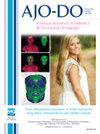Comparative analysis of root resorption and alveolar remodeling in maxillary incisors during orthodontic-orthognathic surgical treatment of skeletal Class III malocclusion
IF 3
2区 医学
Q1 DENTISTRY, ORAL SURGERY & MEDICINE
American Journal of Orthodontics and Dentofacial Orthopedics
Pub Date : 2025-05-01
DOI:10.1016/j.ajodo.2024.12.007
引用次数: 0
Abstract
Introduction
This retrospective clinical study investigated root length and periodontal changes around maxillary incisors in patients with Class III skeletal malocclusion treated with fixed appliances (FAs) and clear aligners (CAs) by cone-beam computed tomography.
Methods
A total of 60 patients were equally divided into 2 groups based on the appliance type; cone-beam computed tomography scans were obtained before treatment, after presurgical orthodontic treatment, and after orthodontic-orthognathic treatment. The measurements of root length, vertical alveolar bone level, and horizontal alveolar bone thickness at 4 levels (3, 6, and 9 mm from the cementoenamel junction and root apex level) surrounding the maxillary incisors were compared. The tooth movement of maxillary incisors during the presurgical phase was evaluated.
Results
The root length of maxillary incisors decreased in both groups, with the CA group experiencing a small reduction (1.09 ± 0.70 mm) compared with the FA group (1.29 ± 0.73 mm) after treatment. The FA group showed more pronounced reductions in palatal alveolar bone thickness and vertical alveolar bone level, along with greater root lingual movement during the presurgical orthodontic phase. Postsurgically, although both groups saw an increase in labial incisor inclination, the FA group primarily exhibited root lingual movement, as opposed to the labial tipping movement observed in the CA group.
Conclusions
The results indicated that FAs and CAs could trigger root resorption and marginal alveolar bone loss, with FA treatment associated with a more pronounced impact. Although CA may offer advantages in minimizing root resorption and conserving alveolar bone integrity, it provides inferior control over anterior torque compared with FA. Careful consideration is crucial to prevent iatrogenic degeneration during the whole phase of orthodontic-orthognathic surgical treatment.
正畸-正颌手术治疗骨性III类错颌时上颌门牙根吸收与牙槽骨重塑的比较分析。
简介:本回顾性临床研究通过锥形束计算机断层扫描研究了使用固定矫治器(FAs)和清除矫治器(CAs)治疗的III类骨骼错颌患者的牙根长度和牙周变化。方法:60例患者按矫治器类型分为两组;在治疗前、手术前正畸治疗后和正畸-正颌治疗后进行锥束计算机断层扫描。比较上颌切牙周围4个水平(距牙髓-牙釉质交界处3、6、9 mm)的牙根长度、垂直牙槽骨水平和水平牙槽骨厚度。观察上颌切牙在术前的运动情况。结果:两组患者的上颌切牙根长度均有所减少,CA组较FA组(1.29±0.73 mm)减少了1.09±0.70 mm。在手术前正畸阶段,FA组的腭牙槽骨厚度和垂直牙槽骨水平下降更明显,牙根舌运动更大。术后,虽然两组患者的唇切牙倾斜度均有所增加,但FA组患者主要表现为舌根运动,与CA组患者的唇倾运动相反。结论:结果表明,FAs和CAs可引发牙根吸收和边缘牙槽骨丢失,其中FA治疗的影响更为明显。尽管CA在减少牙根吸收和保持牙槽骨完整性方面具有优势,但与FA相比,CA对前路扭矩的控制较差。在正畸-正颌手术治疗的整个阶段,仔细考虑预防医源性变性是至关重要的。
本文章由计算机程序翻译,如有差异,请以英文原文为准。
求助全文
约1分钟内获得全文
求助全文
来源期刊
CiteScore
4.80
自引率
13.30%
发文量
432
审稿时长
66 days
期刊介绍:
Published for more than 100 years, the American Journal of Orthodontics and Dentofacial Orthopedics remains the leading orthodontic resource. It is the official publication of the American Association of Orthodontists, its constituent societies, the American Board of Orthodontics, and the College of Diplomates of the American Board of Orthodontics. Each month its readers have access to original peer-reviewed articles that examine all phases of orthodontic treatment. Illustrated throughout, the publication includes tables, color photographs, and statistical data. Coverage includes successful diagnostic procedures, imaging techniques, bracket and archwire materials, extraction and impaction concerns, orthognathic surgery, TMJ disorders, removable appliances, and adult therapy.

 求助内容:
求助内容: 应助结果提醒方式:
应助结果提醒方式:


